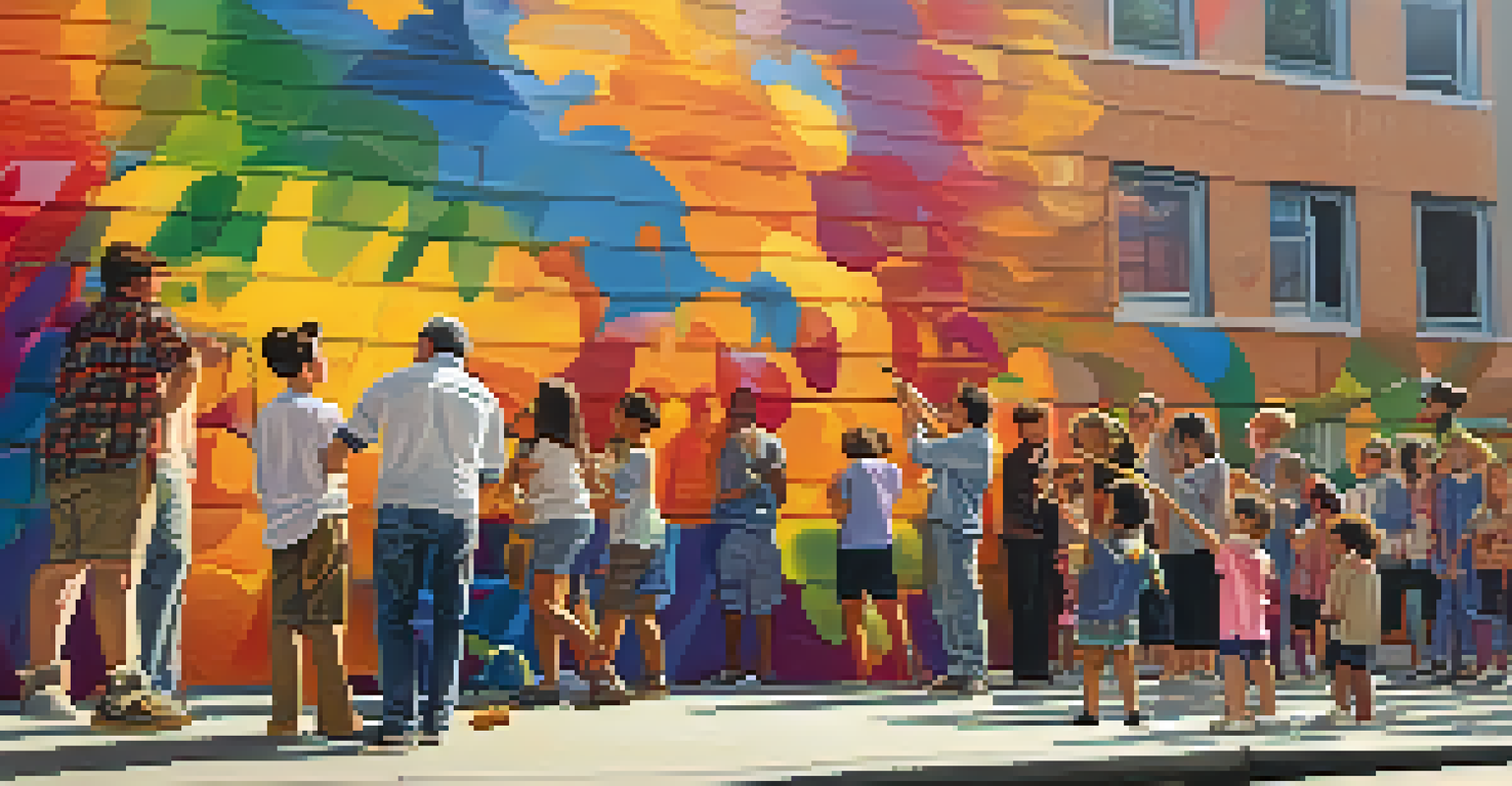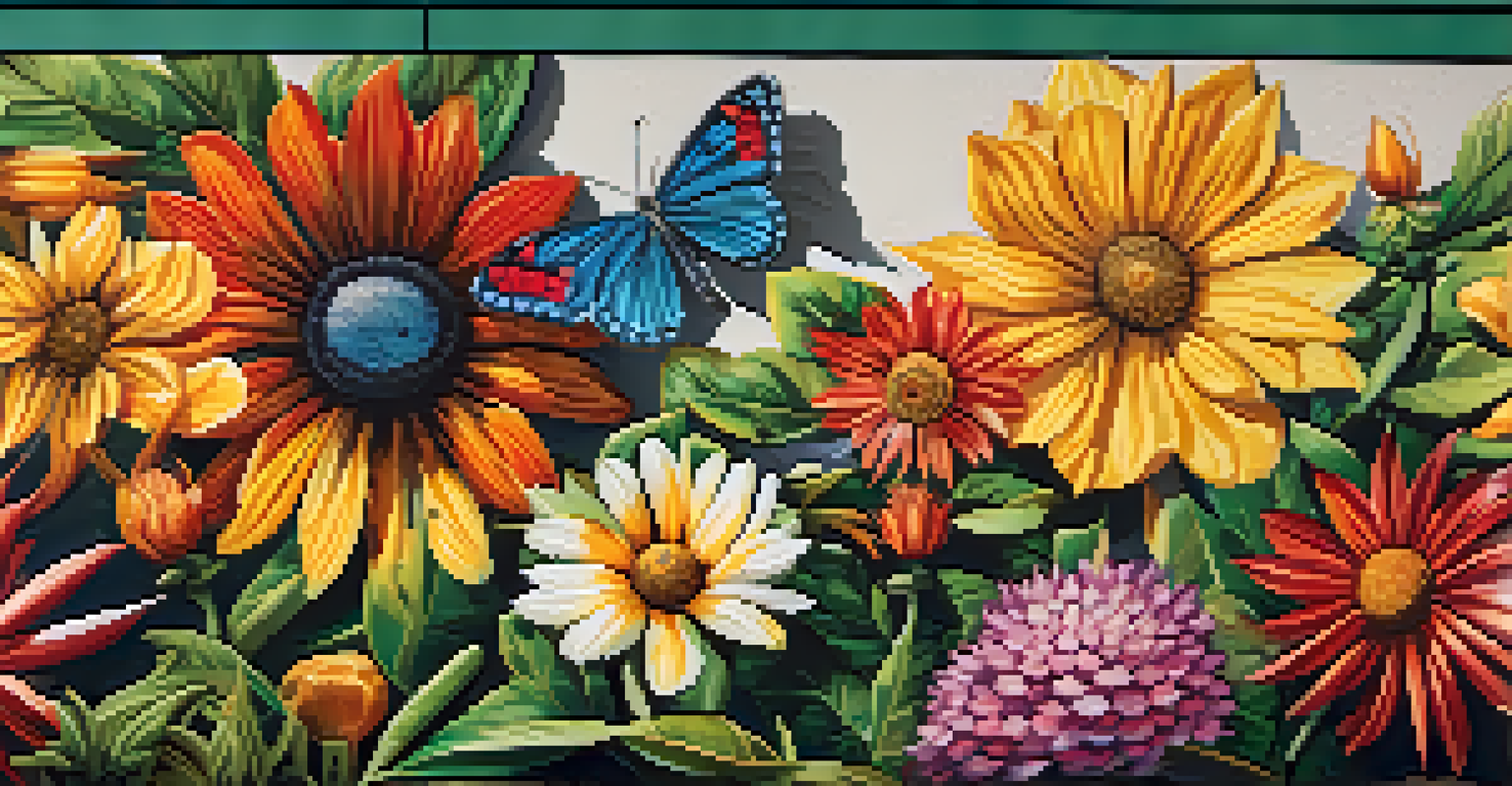The Role of Muralists in Community Identity and Pride

Muralists as Cultural Storytellers in Communities
Muralists often serve as the voice of a community, using their art to tell stories that resonate with local history and culture. Each brushstroke can evoke memories, traditions, and values that might otherwise be forgotten. By portraying these narratives visually, muralists help preserve the unique identity of their neighborhoods, making art an essential part of community heritage.
Art is not a mirror to reflect the world, but a hammer with which to shape it.
For instance, a mural depicting local landmarks or historical events can foster a sense of belonging among residents. When people see their shared experiences reflected in public art, it cultivates a connection to their surroundings and to one another. This storytelling aspect of murals not only beautifies a space but also reinforces community bonds.
Moreover, these cultural narratives can attract visitors, sparking interest in the community’s history and encouraging tourism. As murals draw attention, they invite conversations about the community’s identity, further solidifying its place in the broader cultural landscape.
Enhancing Public Spaces Through Vibrant Artwork
Murals have the power to transform dull or neglected spaces into vibrant, inviting areas that enhance public life. A once-bland wall can become a canvas for creativity, attracting people and encouraging them to engage with their environment. This revitalization can foster community pride and ownership, as residents take pride in their visually appealing public spaces.

One excellent example is the famous Wynwood Walls in Miami, where the neighborhood has been transformed into an outdoor gallery. This project not only showcases the talent of various muralists but also has boosted local businesses and made the area a cultural hotspot. Such transformations demonstrate how murals can breathe new life into urban areas.
Murals as Community Narratives
Muralists use their art to reflect and preserve local stories and cultural identities, fostering a sense of belonging among residents.
As public spaces become more engaging through murals, they also encourage social interaction and community gatherings. People are more likely to spend time in areas that are visually stimulating, leading to increased foot traffic and creating opportunities for local events, markets, and festivals.
Fostering Community Pride and Ownership
Murals often serve as a source of pride for community members, reflecting their shared values and aspirations. When residents see their stories and culture represented in public art, it can instill a sense of ownership and pride in their environment. This feeling of belonging can be empowering and can transform how individuals view their community.
Public art can create a sense of place, identity, and pride in a community.
For example, community-led mural projects often involve local artists and residents in the design process. This collaboration ensures that the final artwork reflects the community’s identity and aspirations, making it a true representation of their collective voice. This participatory approach not only enhances the mural's significance but also fosters deeper connections among residents.
When communities take pride in their murals, they are more likely to care for their surroundings, leading to cleaner and more vibrant neighborhoods. This pride can also inspire other initiatives aimed at beautifying the area, creating a ripple effect of positive change.
Promoting Social Change Through Art
Muralists often tackle social issues through their artwork, using it as a platform to raise awareness and promote change. By addressing topics such as inequality, environmental concerns, or mental health, murals can spark important conversations within the community. These artworks become more than just visually appealing; they serve as catalysts for social action and dialogue.
For instance, murals depicting scenes of unity and diversity can challenge stereotypes and promote inclusivity. When a community sees its values represented in art, it can inspire collective efforts to address social issues and foster understanding among residents. This transformative power of art underscores the role of muralists as agents of change.
Economic Boost from Murals
Vibrant murals attract tourists and enhance local businesses, contributing to economic growth within communities.
Furthermore, by engaging the community in discussions around these themes, muralists can encourage active participation in local efforts aimed at creating a better society. This can lead to increased awareness and motivation to address pressing social challenges, making art an essential tool for advocacy.
Bridging Generational Gaps with Art
Murals can act as a bridge between generations, allowing different age groups to connect through shared visual experiences. While younger generations may appreciate the contemporary styles and themes, older community members can find nostalgia in historical references depicted in the art. This shared appreciation fosters dialogue and understanding between age groups.
For example, a mural that combines traditional art techniques with modern styles can resonate with both the youth and the older generation, sparking conversations about artistic evolution and cultural heritage. These interactions can create a sense of unity and respect among community members of all ages.
Additionally, mural projects that involve workshops for different age groups can encourage collaboration and mentorship, ensuring that the knowledge of artistic skills and community stories is passed down. This not only enriches the community but also strengthens intergenerational ties.
Economic Benefits of Community Murals
Murals can provide significant economic benefits to communities, attracting visitors and stimulating local businesses. When a neighborhood becomes known for its vibrant murals, it can draw tourists eager to experience the art scene. This influx of visitors can lead to increased sales for local shops and restaurants, boosting the economy.
A great example of this is the street art scene in cities like Philadelphia, where murals have become a significant part of the tourism landscape. As tourists flock to see these impressive works of art, local businesses enjoy the economic benefits, creating a win-win situation for everyone involved.
Engagement Through Artistic Collaboration
Community involvement in mural creation fosters collaboration and strengthens bonds, ensuring the artwork resonates with local values.
Moreover, murals can also lead to higher property values in the surrounding areas. As neighborhoods become more visually appealing and culturally rich, they attract new residents and investments, transforming local economies and enhancing community vitality.
The Role of Muralists in Community Engagement
Muralists often engage with the community throughout the creative process, ensuring that their work reflects the collective voice of residents. This engagement fosters a sense of collaboration and shared purpose, allowing community members to feel invested in the artwork. Such involvement can lead to a deeper appreciation for the art and the stories behind it.
Workshops and community meetings are often organized to gather input and ideas, making the mural a product of collective creativity. This participatory approach not only enriches the artwork but also strengthens community bonds and encourages dialogue among residents.

When community members take part in the mural creation process, it can empower individuals and groups to express their ideas and concerns. This engagement often leads to a stronger sense of ownership over the mural and the message it conveys, enhancing the overall impact of the artwork.